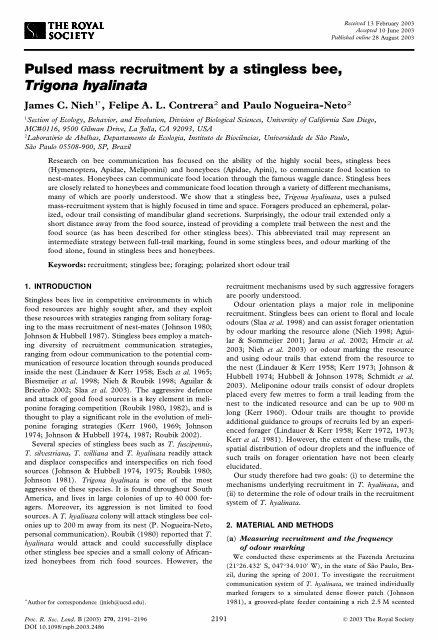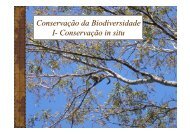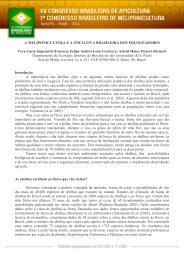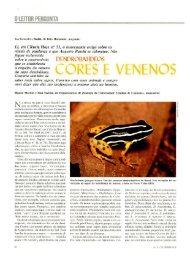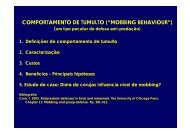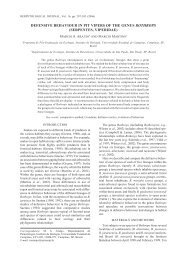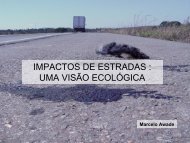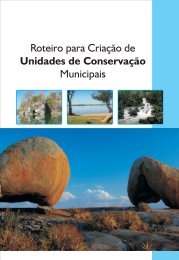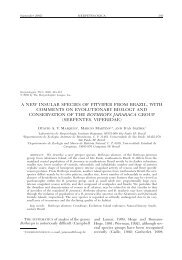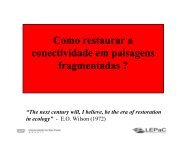Pulsed mass recruitment by a stingless bee, Trigona hyalinata
Pulsed mass recruitment by a stingless bee, Trigona hyalinata
Pulsed mass recruitment by a stingless bee, Trigona hyalinata
You also want an ePaper? Increase the reach of your titles
YUMPU automatically turns print PDFs into web optimized ePapers that Google loves.
Received 13 February 2003<br />
Accepted 10 June 2003<br />
Published online 28 August 2003<br />
<strong>Pulsed</strong> <strong>mass</strong> <strong>recruitment</strong> <strong>by</strong> a <strong>stingless</strong> <strong>bee</strong>,<br />
<strong>Trigona</strong> <strong>hyalinata</strong><br />
James C. Nieh 1* , Felipe A. L. Contrera 2 and Paulo Nogueira-Neto 2<br />
1<br />
Section of Ecology, Behavior, and Evolution, Division of Biological Sciences, University of California San Diego,<br />
MC#0116, 9500 Gilman Drive, La Jolla, CA 92093, USA<br />
2<br />
Laboratório de Abelhas, Departamento de Ecologia, Instituto de Biociências, Universidade de São Paulo,<br />
São Paulo 05508-900, SP, Brazil<br />
Research on <strong>bee</strong> communication has focused on the ability of the highly social <strong>bee</strong>s, <strong>stingless</strong> <strong>bee</strong>s<br />
(Hymenoptera, Apidae, Meliponini) and honey<strong>bee</strong>s (Apidae, Apini), to communicate food location to<br />
nest-mates. Honey<strong>bee</strong>s can communicate food location through the famous waggle dance. Stingless <strong>bee</strong>s<br />
are closely related to honey<strong>bee</strong>s and communicate food location through a variety of different mechanisms,<br />
many of which are poorly understood. We show that a <strong>stingless</strong> <strong>bee</strong>, <strong>Trigona</strong> <strong>hyalinata</strong>, uses a pulsed<br />
<strong>mass</strong>-<strong>recruitment</strong> system that is highly focused in time and space. Foragers produced an ephemeral, polarized,<br />
odour trail consisting of mandibular gland secretions. Surprisingly, the odour trail extended only a<br />
short distance away from the food source, instead of providing a complete trail between the nest and the<br />
food source (as has <strong>bee</strong>n described for other <strong>stingless</strong> <strong>bee</strong>s). This abbreviated trail may represent an<br />
intermediate strategy between full-trail marking, found in some <strong>stingless</strong> <strong>bee</strong>s, and odour marking of the<br />
food alone, found in <strong>stingless</strong> <strong>bee</strong>s and honey<strong>bee</strong>s.<br />
Keywords: <strong>recruitment</strong>; <strong>stingless</strong> <strong>bee</strong>; foraging; polarized short odour trail<br />
1. INTRODUCTION<br />
Stingless <strong>bee</strong>s live in competitive environments in which<br />
food resources are highly sought after, and they exploit<br />
these resources with strategies ranging from solitary foraging<br />
to the <strong>mass</strong> <strong>recruitment</strong> of nest-mates (Johnson 1980;<br />
Johnson & Hubbell 1987). Stingless <strong>bee</strong>s employ a matching<br />
diversity of <strong>recruitment</strong> communication strategies,<br />
ranging from odour communication to the potential communication<br />
of resource location through sounds produced<br />
inside the nest (Lindauer & Kerr 1958; Esch et al. 1965;<br />
Biesmeijer et al. 1998; Nieh & Roubik 1998; Aguilar &<br />
Briceño 2002; Slaa et al. 2003). The aggressive defence<br />
and attack of good food sources is a key element in meliponine<br />
foraging competition (Roubik 1980, 1982), and is<br />
thought to play a significant role in the evolution of meliponine<br />
foraging strategies (Kerr 1960, 1969; Johnson<br />
1974; Johnson & Hubbell 1974, 1987; Roubik 2002).<br />
Several species of <strong>stingless</strong> <strong>bee</strong>s such as T. fuscipennis,<br />
T. silvestriana, T. williana and T. <strong>hyalinata</strong> readily attack<br />
and displace conspecifics and interspecifics on rich food<br />
sources ( Johnson & Hubbell 1974, 1975; Roubik 1980;<br />
Johnson 1981). <strong>Trigona</strong> <strong>hyalinata</strong> is one of the most<br />
aggressive of these species. It is found throughout South<br />
America, and lives in large colonies of up to 40 000 foragers.<br />
Moreover, its aggression is not limited to food<br />
sources. A T. <strong>hyalinata</strong> colony will attack <strong>stingless</strong> <strong>bee</strong> colonies<br />
up to 200 m away from its nest (P. Nogueira-Neto,<br />
personal communication). Roubik (1980) reported that T.<br />
<strong>hyalinata</strong> would attack and could successfully displace<br />
other <strong>stingless</strong> <strong>bee</strong> species and a small colony of Africanized<br />
honey<strong>bee</strong>s from rich food sources. However, the<br />
*<br />
Author for correspondence (jnieh@ucsd.edu).<br />
<strong>recruitment</strong> mechanisms used <strong>by</strong> such aggressive foragers<br />
are poorly understood.<br />
Odour orientation plays a major role in meliponine<br />
<strong>recruitment</strong>. Stingless <strong>bee</strong>s can orient to floral and locale<br />
odours (Slaa et al. 1998) and can assist forager orientation<br />
<strong>by</strong> odour marking the resource alone (Nieh 1998; Aguilar<br />
& Sommeijer 2001; Jarau et al. 2002; Hrncir et al.<br />
2003; Nieh et al. 2003) or odour marking the resource<br />
and using odour trails that extend from the resource to<br />
the nest (Lindauer & Kerr 1958; Kerr 1973; Johnson &<br />
Hubbell 1974; Hubbell & Johnson 1978; Schmidt et al.<br />
2003). Meliponine odour trails consist of odour droplets<br />
placed every few metres to form a trail leading from the<br />
nest to the indicated resource and can be up to 900 m<br />
long (Kerr 1960). Odour trails are thought to provide<br />
additional guidance to groups of recruits led <strong>by</strong> an experienced<br />
forager (Lindauer & Kerr 1958; Kerr 1972, 1973;<br />
Kerr et al. 1981). However, the extent of these trails, the<br />
spatial distribution of odour droplets and the influence of<br />
such trails on forager orientation have not <strong>bee</strong>n clearly<br />
elucidated.<br />
Our study therefore had two goals: (i) to determine the<br />
mechanisms underlying <strong>recruitment</strong> in T. <strong>hyalinata</strong>, and<br />
(ii) to determine the role of odour trails in the <strong>recruitment</strong><br />
system of T. <strong>hyalinata</strong>.<br />
2. MATERIAL AND METHODS<br />
(a) Measuring <strong>recruitment</strong> and the frequency<br />
of odour marking<br />
We conducted these experiments at the Fazenda Aretuzina<br />
(21°26.4329 S, 047°34.9109 W), in the state of São Paulo, Brazil,<br />
during the spring of 2001. To investigate the <strong>recruitment</strong><br />
communication system of T. <strong>hyalinata</strong>, we trained individually<br />
marked foragers to a simulated dense flower patch ( Johnson<br />
1981), a grooved-plate feeder containing a rich 2.5 M scented<br />
Ó Proc. R. Soc. Lond. B (2003) 270, 2191–2196 2191 2003 The Royal Society<br />
DOI 10.1098/rspb.2003.2486
2192 J. C. Nieh and others Stingless <strong>bee</strong> pulsed <strong>mass</strong> <strong>recruitment</strong><br />
sucrose solution (100 m l of anise extract per litre of solution,<br />
McCormick & Co. Inc.) located 146 m SW of the nest (method<br />
of von Frisch 1967). The control and experimental feeders were<br />
identical and contained the same quantities of scented 2.5 M<br />
sucrose solution. However, we immediately captured all <strong>bee</strong>s<br />
landing on the control feeder to eliminate <strong>recruitment</strong> to the<br />
control feeder. We marked each visiting <strong>bee</strong> with an individual<br />
combination of paint marks on the thorax. We monitored the<br />
visiting foragers each 15 min and allowed only 10 individually<br />
marked foragers to feed. We captured all other foragers with<br />
aspirators and did not release them. Thus foragers were not multiply<br />
counted.<br />
A newcomer is a forager from the subject colony who has not<br />
previously visited any feeder (Biesmeijer & de Vries 2001). To<br />
determine whether foragers visiting the feeder came from the<br />
subject colony and were motivated <strong>by</strong> recruiters to find the food<br />
source, we counted the number of newcomers arriving after we<br />
eliminated <strong>recruitment</strong> <strong>by</strong> capturing all foragers. We conducted<br />
three hour-long control trials on three separate days.<br />
Stingless <strong>bee</strong>s deposit odour trails <strong>by</strong> preferentially placing<br />
odour marks on prominent leaves elevated above the substrate.<br />
They will also odour mark leaves placed on an elevated rope,<br />
creating a trail with odour marks spaced along the rope, as they<br />
are on a natural substrate (Lindauer & Kerr 1958; Kerr et al.<br />
1963). To study the odour trail, we therefore attached a 100 m<br />
rope leading from the feeder towards the nest and fastened<br />
leaves at 1 m intervals along the rope (method of Lindauer &<br />
Kerr 1960). We attached leaves at 1 m intervals to all ropes used<br />
in our experiments. This technique allows one to move <strong>stingless</strong><br />
<strong>bee</strong> pheromone trails <strong>by</strong> shifting the location of the rope.<br />
Observers followed odour-marking <strong>bee</strong>s and recorded mark<br />
locations to the nearest 0.5 m.<br />
To analyse marking behaviour in detail, we digitally videotaped<br />
foragers depositing odour marks on a leaf attached to the<br />
feeder, and analysed the video (30 frames s 2 1 ) on a Macintosh<br />
iBook computer with iMovie software.<br />
(b) Testing the attractiveness of odour marks<br />
deposited on the resource<br />
We tested the attractiveness of putative odour marks in a<br />
paired-feeder assay. We offered newcomers a choice between<br />
two identical clean feeders. Around each feeder, we placed a<br />
ring of filter paper: one paper that had <strong>bee</strong>n putatively marked<br />
<strong>by</strong> foragers for 60 min, and one that foragers had not contacted.<br />
We placed feeders 1 m to the right and to the left of the original<br />
feeding site and captured <strong>bee</strong>s as soon as they landed. During<br />
odour bioassays, we immediately captured all <strong>bee</strong>s as soon as<br />
they landed on a feeder and only counted individual choices<br />
made in the absence of other <strong>bee</strong>s. We exchanged the control<br />
and experimental feeder positions at 1 min intervals to eliminate<br />
site bias (total trial time of 5 min) and discontinued the bioassays<br />
when the wind direction was not parallel to the feederto-nest<br />
axis and thus could have biased foragers to visit one<br />
feeder over the other. During the trials, such wind conditions<br />
occurred twice for intervals of ca. 15 min each.<br />
(c) Testing the attractiveness of the odour trail<br />
To test the attractiveness of the odour trail, we performed<br />
a V-shaped rope experiment with the leaf-bedecked ropes. We<br />
attached one end of a 50 m rope (the nest-proximal end) to a<br />
tripod 96 m from the nest. We attached the distal end of the<br />
rope to a feeder 146 m from the nest. The rope pointed directly<br />
towards the nest. In the odour-collection phase, we allowed for-<br />
agers to odour-mark the rope for 30 min. In the test phase, we<br />
removed the original training feeder, sealed it inside a plastic<br />
bag, and set out two identical, clean feeders, 10 m to the left<br />
and right of the training location. We then moved the distal end<br />
of the marked rope to one of the clean feeders and attached an<br />
identical but unmarked rope to the other clean feeder. We<br />
attached the proximal ends of both ropes to the same tripod and<br />
thus formed a V-shaped rope array. We alternated the position<br />
of the marked rope from trial to trial.<br />
(d) The spatial distribution of odour marks<br />
To determine the spatial distribution of odour marks, we<br />
intersected two perpendicular crossed ropes at the training<br />
feeder. From the feeder, the ropes extended for 100 m in the<br />
direction of the nest, 20 m in the other three directions. Three<br />
observers recorded the location and sequence of all odour marks<br />
deposited on the ropes to an accuracy of 0.5 m.<br />
(e) Testing the polarity of the odour trail<br />
We tested newcomer orientation within the trail <strong>by</strong> providing<br />
a choice between the training feeder and an identical control<br />
feeder located within the trail but 20 m closer to the nest. The<br />
trail extended 27 m away from the feeder in the direction of the<br />
nest, as determined <strong>by</strong> the maximum extent of odour marking<br />
on the rope (see § 3).<br />
(f ) Testing mandibular gland extracts<br />
Several <strong>stingless</strong> <strong>bee</strong> species use mandibular gland pheromone<br />
to odour-mark food sources and to create odour trails (Kerr et<br />
al. 1963; Blum et al. 1970). We observed T. <strong>hyalinata</strong> foragers<br />
appearing to odour-mark <strong>by</strong> briefly landing and rubbing their<br />
mandibles against the substrate. We therefore extracted and<br />
tested the attractiveness of T. <strong>hyalinata</strong> mandibular gland pheromone.<br />
We prepared extracts <strong>by</strong> using plastic bags to carefully capture<br />
non-alarmed foragers leaving the feeder, chilling the <strong>bee</strong>s, and<br />
dissecting out the mandibular glands. We crushed three glands<br />
in 1.5 ml of hexane (to standardize extract concentration), and<br />
stored 0.5 ml of the extract in a sealed centrifuge vial at 220 °C<br />
until the beginning of the bioassay, when we attached and<br />
opened the tube on the side of a feeder. Control vials contained<br />
0.5 ml of hexane and were handled and stored in the same way,<br />
but did not contain mandibular gland pheromone.<br />
During the collection and test phases, we used two clean forceps,<br />
one to handle the test filter paper and one to handle the<br />
control filter paper. We kept a supply of several clean glass feeders<br />
on hand. Once used, we washed the forceps and test feeders<br />
in a strong detergent, rinsing thoroughly with hot water followed<br />
<strong>by</strong> two washes of 95% ethanol. We air-dried all apparatus for<br />
at least 3 h before reuse. Even without washing, this time-interval<br />
is more than sufficient for any odour marks to completely<br />
evaporate (see figure 4). The experimenter wore disposable latex<br />
gloves during all feeder choice experiments and while washing<br />
glassware. After each trial, we discarded the gloves and all paper<br />
and plastic items used in the trial.<br />
(g) Statistical analyses<br />
We use the x 2 -test to determine the significance of the <strong>recruitment</strong><br />
control trials. In two-feeder experiments, we calculate<br />
probabilities from a two-tailed binomial distribution with<br />
p = q = 0.5.<br />
Proc. R. Soc. Lond. B (2003)
Stingless <strong>bee</strong> pulsed <strong>mass</strong> <strong>recruitment</strong> J. C. Nieh and others 2193<br />
(a)<br />
40<br />
30<br />
count<br />
15<br />
0<br />
(b)<br />
160<br />
0 40 80 120 160<br />
time from start of trial (min)<br />
number of <strong>bee</strong>s<br />
30<br />
20<br />
10<br />
0<br />
trial 1 2 3 4<br />
p < 0.0001 0.0004 0.026 0.009<br />
time of <strong>recruitment</strong> pulse (min)<br />
120<br />
80<br />
40<br />
Figure 2. Attractiveness of odours deposited <strong>by</strong> foragers on<br />
the feeder. Feeder choice experiment. Black bars, previously<br />
visited feeder; open bars, clean feeder.<br />
the rope and feeder. Foragers did not land on any other<br />
substrate. The putative odour-marking behaviour consisted<br />
of a forager landing for 1.35 ± 0.66 s (s.d.) while<br />
rubbing her mandibles for 0.66 ± 0.64 s against the<br />
substrate. In 57% of landings, foragers also rubbed their<br />
tongues against the substrate for 0.13 ± 0.06 s (n = 32<br />
observations).<br />
0<br />
0<br />
40 80 120 160<br />
time of odour-marking pulse (min)<br />
Figure 1. Temporal synchronization of <strong>recruitment</strong> and<br />
odour marking. (a) Recruitment occurs in pulses (trial 1,<br />
10.00 start time, n = 231 newcomers). Black bars show the<br />
number of recruits. Open bars show intervals of forager<br />
odour marking. (b) Timing of major <strong>recruitment</strong> pulses is<br />
tightly linked to odour deposition. Start (open circles) and<br />
stop (filled circles) times of <strong>recruitment</strong> and odour-marking<br />
pulses are plotted. Data from five trials. Linear regression<br />
line shown: r 2 = 0.98, p , 0.0001. Scale bar, 5 mm.<br />
3. RESULTS<br />
(a) Measuring <strong>recruitment</strong> and observing odour<br />
marking<br />
Foragers recruited in large pulses in which over 100<br />
newcomers could arrive within a 15–20 min interval (five<br />
trials, 3 h each trial; figure 1a). No newcomers arrived<br />
once the marked foragers were captured during three<br />
hour-long control trials conducted over 3 days, although<br />
a significantly greater number of newcomers had arrived<br />
in an equal time-period immediately before each foragerremoval<br />
trial (three trials, x 2 = 8, 1 d.f., p < 0.005). Newcomer<br />
arrivals therefore decreased significantly once we<br />
removed the foragers at the feeder. Based upon these<br />
results, we counted unmarked foragers as newcomers from<br />
our subject colony.<br />
The largest <strong>recruitment</strong> burst was 201 newcomers in<br />
11 min. In addition, foragers landed and deposited putative<br />
odour marks on the feeder and rope during large<br />
<strong>recruitment</strong> bursts. The start and stop times of major<br />
<strong>recruitment</strong> pulses (more than one newcomer per min) are<br />
highly correlated with the start and stop times of the putative<br />
odour marking (figure 1b). Foragers landed only on<br />
(b) Testing the attractiveness of odour marks<br />
deposited on the resource<br />
Significantly more newcomers chose the feeder with the<br />
forager-marked filter paper in all trials (figure 2; two-tailed<br />
binomial probability, pooled data, two-tailed binomial<br />
probability, p ¿ 0.000 01, four trials, n = 118 newcomers).<br />
Thus foragers evidently deposited attractive odour marks<br />
on the feeder.<br />
(c) Testing the attractiveness of the short odour<br />
trail<br />
We next tested the attractiveness of odour marks on the<br />
rope with the V-shaped rope experiment. A significant<br />
majority of newcomers (61–94%) chose the feeder linked<br />
to the forager-marked rope over the feeder linked to the<br />
unmarked rope within the first 15 min (pooled data, twotailed<br />
binomial probability, p ¿ 0.000 01, five trials,<br />
n = 244 newcomers). Thus forager-deposited odour marks<br />
on the rope could also guide newcomers to a feeder.<br />
(d) The spatial distribution of odour marks<br />
Unlike previous descriptions of <strong>stingless</strong> <strong>bee</strong> <strong>recruitment</strong><br />
trails, these odour marks did not form a trail leading<br />
the entire distance from the nest to the food source<br />
(Lindauer & Kerr 1960). Instead, the marks extended only<br />
a short distance from the food source. We therefore call<br />
this formation a short odour trail. When we centred<br />
crossed ropes on the feeder, foragers laid most marks in<br />
the nest direction and occasionally deposited multiple<br />
marks during a single marking run (figure 3a,b). The<br />
marks formed a decreasing concentration gradient<br />
extending a maximum of 27 m from the feeder (three<br />
trials; figure 3c).<br />
(e) Testing the polarity of the short odour trail<br />
Because the concentration gradient polarizes the short<br />
odour trail, it may allow newcomers to determine the cor-<br />
Proc. R. Soc. Lond. B (2003)
2194 J. C. Nieh and others Stingless <strong>bee</strong> pulsed <strong>mass</strong> <strong>recruitment</strong><br />
(a)<br />
(m)<br />
(b)<br />
1<br />
0<br />
1<br />
54<br />
14 75 86 93<br />
100<br />
nest<br />
proportion choosing experimental feeder<br />
1.0<br />
0.8<br />
0.6<br />
0.4<br />
0.2<br />
m<br />
(c)<br />
(m)<br />
(m)<br />
–1 0 1 2 3 4 5 6 7 8 9<br />
0 5 10 15 20 25 30<br />
Figure 3. Short, polarized odour trail created <strong>by</strong> recruiting<br />
foragers. (a) Crossed-ropes experiment. Odour marks<br />
(n = 81) are most concentrated at the food source (0 m), and<br />
decrease in number in the direction of the nest. Area of<br />
circles corresponds to the number of marks. Isoclines give<br />
the percentage of marks within set distances. (b) Deposition<br />
sequence of multiple marks during individual marking runs<br />
on crossed ropes. Initial mark shown as a circle. Arrows<br />
indicate subsequent marks. Paths vertically displaced to show<br />
the marking pattern better. (c) Maximum extent of short<br />
odour trail (n = 103 marks).<br />
rect endpoint. Significantly more newcomers chose the<br />
training feeder in all polarity-test trials (six trials, pooled<br />
data: p ¿ 0.000 01, n = 75 newcomers). Thus newcomers<br />
preferred to land in the region of highest pheromone<br />
mark concentration.<br />
(f ) Testing mandibular gland extracts<br />
Using the paired-feeder assay, we presented the equivalent<br />
of one mandibular gland in hexane at the experimental<br />
feeder and a hexane blank at the control feeder. From 0<br />
to 8 min, newcomers attacked the extract vial <strong>by</strong> hovering<br />
and biting the vial lip. Newcomers did not land and feed<br />
until after 8 min had passed. From 8 to 20 min, they<br />
showed a strong preference for landing and feeding on the<br />
experimental feeder over the control feeder (60–91% on<br />
the experimental, three trials, two-tailed binomial probability,<br />
p = 0.0003, n = 273 newcomers; figure 4). Attraction<br />
to the mandibular gland extract thus persisted for<br />
12 min, corresponding well to the 15 min period in which<br />
the naturally deposited short odour trail influenced newcomer<br />
choice.<br />
4. DISCUSSION<br />
Our experiments reveal that T. <strong>hyalinata</strong> foragers can<br />
recruit a large number of nest-mates in <strong>recruitment</strong> pulses<br />
that are highly focused in time and space (figure 1a): 10<br />
foragers recruited up to 201 newcomers in 11 min.<br />
Because recruiters and newcomers arrived in large groups,<br />
0 10 20 30 40<br />
time (min)<br />
Figure 4. Mandibular gland extracts attract foragers to land<br />
and to begin feeding from 7 to 20 min after deposition. Inset<br />
shows dissected mandibular gland (m) attached to a<br />
mandible (scale bar, 1 mm). The graph shows the results of<br />
three trials.<br />
recruiters may have guided recruits from the nest and<br />
assisted final recruit orientation with a short, polarized<br />
odour trail. This short odour trail extended only a short<br />
distance from the food source instead of providing a complete<br />
trail between the nest and the food source. The<br />
<strong>stingless</strong> <strong>bee</strong> Scaptotrigona postica also deposits a polarized<br />
odour trail (Kerr et al. 1963). However, most previously<br />
reported <strong>stingless</strong> <strong>bee</strong> odour trails have extended from the<br />
nest to the food source (Lindauer & Kerr 1958; Kerr et<br />
al. 1963, 1981). Kerr & Rocha (1988) reported potential<br />
odour-marking behaviour that may have created a short<br />
odour trail in Melipona rufiventris and M. compressipes, but<br />
it is unclear whether the potential marks were attractive<br />
to nest-mates.<br />
Mandibular gland volatiles serve as alarm odours in<br />
honey<strong>bee</strong>s and many <strong>stingless</strong> <strong>bee</strong> species (Cruz-Landim<br />
1967; Collins et al. 1989). <strong>Trigona</strong> <strong>hyalinata</strong> recruiters evidently<br />
use mandibular gland secretions to create the short<br />
odour trail to guide nest-mates. Chemical analysis of the<br />
odour marks is necessary to confirm their identity, but the<br />
deposition behaviour is characteristic of <strong>stingless</strong> <strong>bee</strong> mandibular<br />
gland marking, and mandibular gland extracts<br />
attracted foragers and exhibited a similar decay time to<br />
natural odour marks. Mandibular gland pheromone may<br />
also release an aggressive response in T. <strong>hyalinata</strong>, as it<br />
does in other highly social <strong>bee</strong>s (Cruz-Landim 1967;<br />
Williams 1982; Collins et al. 1989). <strong>Trigona</strong> <strong>hyalinata</strong> is<br />
known to be an aggressive species that attacks and displaces<br />
other species at food sources (Roubik 1980).<br />
Recruited nest-mates were drawn to the highest concentration<br />
of odour marks, and thus mandibular gland pheromone<br />
could enable foragers to draw in reinforcements<br />
precisely where they are most needed to take over a rich<br />
food source.<br />
Food-source competition may be an important factor in<br />
<strong>stingless</strong> <strong>bee</strong> evolution (Johnson 1974; Johnson & Hubbell<br />
1974, 1987; Hubbell & Johnson 1978; Slaa et al. 1997).<br />
Several <strong>stingless</strong> <strong>bee</strong> species are reported to forage<br />
Proc. R. Soc. Lond. B (2003)
Stingless <strong>bee</strong> pulsed <strong>mass</strong> <strong>recruitment</strong> J. C. Nieh and others 2195<br />
aggressively, and elements of the pulsed <strong>mass</strong>-<strong>recruitment</strong><br />
system—mandibular gland marking of resources, <strong>mass</strong>ive<br />
<strong>recruitment</strong> and aggressive attacks at and the defence of<br />
rich resources—are found to varying degrees in the Meliponini<br />
(Kerr et al. 1963; Blum et al. 1970; Roubik 1980).<br />
Some aggressive species appear to specialize in discovering<br />
and exploiting good food sources found <strong>by</strong> other <strong>bee</strong>s<br />
(Johnson 1974; Hubbell & Johnson 1978; Nagamitsu &<br />
Inoue 1997). Thus, it is possible to view the precise spatial<br />
and temporal communication offered <strong>by</strong> the ephemeral,<br />
short odour trail in an alternative light: crypsis. An<br />
extended, consistently renewed odour trail offers a more<br />
conspicuous target than a temporary, short odour trail<br />
(Bradbury & Vehrencamp 1988; Hölldobler & Wilson<br />
1990). The work of Kerr et al. (1963) suggests that some<br />
meliponine species, Scaptotrigona postica and S. xanthotricha,<br />
can detect and use interspecific odour trails. Thus<br />
an abbreviated trail may be less conspicuous to foraging<br />
competitors, and may represent an intermediate strategy<br />
between point-source marking of the resource alone and<br />
full-trail marking from the resource to the nest.<br />
The authors thank Santiago Ramõ´rez, Eda F. L. R. A. Patricio<br />
and Vera L. Imperatriz-Fonseca for their assistance. The comments<br />
of three anonymous reviewers substantially improved<br />
our manuscript. Financial support came from the Heiligenberg<br />
Chair Endowment at UCSD and FAPESP of Brazil.<br />
REFERENCES<br />
Aguilar, I. & Briceño, D. 2002 Sounds in M. costaricensis<br />
(Apidae: Meliponini): effect of sugar concentration and nectar<br />
source distance. Apidologie 33, 375–388.<br />
Aguilar, I. & Sommeijer, M. 2001 The deposition of anal<br />
excretions <strong>by</strong> Melipona favosa foragers (Apidae: Meliponinae):<br />
behavioural observations concerning the location of food<br />
sources. Apidologie 32, 37–48.<br />
Biesmeijer, J. C. & de Vries, H. 2001 Exploration and exploitation<br />
of food sources <strong>by</strong> social insect colonies: a revision of<br />
the scout-recruit concept. Behav. Ecol. Sociobiol. 49, 89–99.<br />
Biesmeijer, J. C., van Nieuwstadt, M. G. L., Lukacs, S. &<br />
Sommeijer, M. J. 1998 The role of internal and external<br />
information in foraging decisions of Melipona workers<br />
(Hymenoptera: Meliponinae). Behav. Ecol. Sociobiol. 42,<br />
107–116.<br />
Blum, M. S., Crewe, R. M., Kerr, W. E., Keith, L. H., Garrison,<br />
A. W. & Walker, M. M. 1970 Citral in <strong>stingless</strong> <strong>bee</strong>s:<br />
isolation and functions in trail-laying and robbing. J. Insect<br />
Physiol. 16, 1637–1648.<br />
Bradbury, J. & Vehrencamp, S. L. 1988 Principles of animal<br />
communication. Sunderland, MA: Sinauer.<br />
Collins, A. M., Rinderer, T. E., Daly, H. V., Harbo, J. R. &<br />
Pesante, D. 1989 Alarm pheromone production <strong>by</strong> two<br />
honey<strong>bee</strong> (Apis mellifera) types. J. Chem. Ecol. 15, 1747–<br />
1756.<br />
Cruz-Landim, C. da 1967 Estudo comparativo de algumas<br />
glândulas das abelhas (Hymenoptera, Apoidea) e respectivas<br />
implicações evolutivas. Arq. Zool. São Paulo 15, 177–290.<br />
Esch, H., Esch, I. & Kerr, W. E. 1965 Sound: an element common<br />
to communication of <strong>stingless</strong> <strong>bee</strong>s and to dances of<br />
the honey <strong>bee</strong>. Science 149, 320–321.<br />
Hölldobler, B. & Wilson, E. 1990 The ants. Cambridge, MA:<br />
The Belknap Press of Harvard University Press.<br />
Hrncir, M., Jarau, S., Zucchi, R. & Barth, F. G. 2003 On the<br />
origin and properties of scent marks deposited at the food<br />
source <strong>by</strong> a <strong>stingless</strong> <strong>bee</strong>, Melipona seminigra Friese 1903.<br />
Apidologie (In the press.)<br />
Hubbell, S. P. & Johnson, L. K. 1978 Comparative foraging<br />
behavior of six <strong>stingless</strong> <strong>bee</strong> species exploiting a standardized<br />
resource. Ecology 59, 1123–1136.<br />
Jarau, S., Hrncir, M., Zucchi, R. & Barth, F. G. 2002 Foot<br />
print pheromones used to mark food sources <strong>by</strong> <strong>stingless</strong><br />
<strong>bee</strong>s. In XIV Int. Congr. IUSSI: the Golden Jubilee Proceedings<br />
(ed. J. Billen), p. 16. Sapporo, Japan: Hokkaido University<br />
Coop.<br />
Johnson, L. K. 1974 The role of agonistic behavior in the foraging<br />
strategies of <strong>Trigona</strong> <strong>bee</strong>s. Berkeley, CA: University of California.<br />
Johnson, L. K. 1980 Foraging strategies and the structure of<br />
<strong>stingless</strong> <strong>bee</strong> communities in Costa Rica. In Proc. 1st Int.<br />
Symp. organized <strong>by</strong> the International Union for the Study of<br />
Social Insects and the Sociedad Mexicana de Entomologia, vol.<br />
2 (ed. P. Jaisson), pp. 31–58. Cocoyoc, Morelos, Mexico:<br />
Centre Régional de Publications de la 5ème Circonscription<br />
du C.N.R.S.<br />
Johnson, L. K. 1981 Effect of flower clumping on defense of<br />
artificial flowers <strong>by</strong> aggressive <strong>stingless</strong> <strong>bee</strong>s. Biotropica 13,<br />
151–157.<br />
Johnson, L. K. & Hubbell, S. P. 1974 Aggression and competition<br />
among <strong>stingless</strong> <strong>bee</strong>s: field studies. Ecology 55, 120–<br />
127.<br />
Johnson, L. K. & Hubbell, S. P. 1975 Contrasting foraging<br />
strategies and coexistence of two <strong>bee</strong> species on a single<br />
resource. Ecology 56, 1398–1406.<br />
Johnson, L. K. & Hubbell, S. P. 1987 Defense of food supply<br />
<strong>by</strong> eusocial colonies. Am. Zool. 27, 347–358.<br />
Kerr, W. E. 1960 Evolution of communication in <strong>bee</strong>s and its<br />
role in speciation. Evolution 14, 326–327.<br />
Kerr, W. E. 1969 Some aspects of the evolution of social <strong>bee</strong>s.<br />
Evol. Biol. 3, 119–175.<br />
Kerr, W. E. 1972 Orientação pelo sol em <strong>Trigona</strong> spinipes. Ciên.<br />
Cultura (Suppl.), 341–342.<br />
Kerr, W. E. 1973 Sun compass orientation in the <strong>stingless</strong><br />
<strong>bee</strong>s, <strong>Trigona</strong> (<strong>Trigona</strong>) spinipes (Fabricius 1793) (Apidae).<br />
Anais Acad. Bras. Ciên 45, 301–308.<br />
Kerr, W. E. & Rocha, R. 1988 Comunicação em Melipona rufiventris<br />
e Melipona compressipes. Ciên. Cultura 40, 1200–1203.<br />
Kerr, W. E., Ferreira, A. & Simões de Mattos, N. 1963 Communication<br />
among <strong>stingless</strong> <strong>bee</strong>s—additional data<br />
(Hymenoptera: Apidae). J. NY Entomol. Soc. 71, 80–90.<br />
Kerr, W. E., Blum, M. & Fales, H. M. 1981 Communication<br />
of food sources between workers of <strong>Trigona</strong> (<strong>Trigona</strong>) spinipes.<br />
Rev. Bras. Biol. 41, 619–623.<br />
Lindauer, M. & Kerr, W. E. 1958 Die gegenseitige Verständigung<br />
bei den stachellosen Bienen. Z. Vergl. Physiol. 41,<br />
405–434.<br />
Lindauer, M. & Kerr, W. E. 1960 Communication between<br />
the workers of <strong>stingless</strong> <strong>bee</strong>s. Bee World 41, 29–41, 65–71.<br />
Nagamitsu, T. & Inoue, T. 1997 Aggressive foraging of social<br />
<strong>bee</strong>s as a mechanism of floral resource partitioning in an<br />
Asian tropical rainforest. Oecologia 110, 432–439.<br />
Nieh, J. C. 1998 The role of a scent beacon in the communication<br />
of food location in the <strong>stingless</strong> <strong>bee</strong>, Melipona panamica.<br />
Behav. Ecol. Sociobiol. 43, 47–58.<br />
Nieh, J. C. & Roubik, D. W. 1998 Potential mechanisms for<br />
the communication of height and distance <strong>by</strong> a <strong>stingless</strong> <strong>bee</strong>,<br />
Melipona panamica. Behav. Ecol. Sociobiol. 43, 387–399.<br />
Nieh, J. C., Ramõ´rez, S. & Nogueira-Neto, P. 2003 Multisource<br />
odor-marking of food <strong>by</strong> a <strong>stingless</strong> <strong>bee</strong>, Melipona<br />
mandacaia. Behav. Ecol. Sociobiol. (In the press.)<br />
Roubik, D. W. 1980 Foraging behavior of competing Africanized<br />
honey<strong>bee</strong>s and <strong>stingless</strong> <strong>bee</strong>s. Ecology 61, 836–845.<br />
Roubik, D. W. 1982 The ecological impact of nectar robbing<br />
<strong>bee</strong>s and pollinating hummingbirds on a tropical shrub.<br />
Ecology 63, 354–360.<br />
Proc. R. Soc. Lond. B (2003)
2196 J. C. Nieh and others Stingless <strong>bee</strong> pulsed <strong>mass</strong> <strong>recruitment</strong><br />
Roubik, D. W. 2002 Tropical <strong>bee</strong> colonies, pollen dispersal,<br />
and reproductive gene flow in tropical trees. In Modeling and<br />
experimental reseach on genetic processes in tropical and temperate<br />
forests (ed. B. Degen, M. D. Loveless & A. Kremer), pp. 31–<br />
41. Belem, Brazil: EMBRAPA.<br />
Schmidt, V. M., Zucchi, R. & Barth, F. G. 2003 A <strong>stingless</strong><br />
<strong>bee</strong> marks the feeding site in addition to the scent path<br />
(Scaptotrigona aff. deplis). Apidologie 34, 237–248.<br />
Slaa, E. J., Cevaal, A. & Sommeijer, M. J. 1998 Floral constancy<br />
in <strong>Trigona</strong> <strong>stingless</strong> <strong>bee</strong>s foraging on artificial flower<br />
patches: a comparative study. J. Apicult. Res. 37, 191–198.<br />
Slaa, E. J., Nieuwstadt, M. G. L. v., Pisa, L. W. & Sommeijer,<br />
M. J. 1997 Foraging strategies of <strong>stingless</strong> <strong>bee</strong>s (Apidae,<br />
Meliponinae): the relation between precision of <strong>recruitment</strong>,<br />
competition and communication. Acta Horticult. 437, 193–197.<br />
Slaa, E. J., Wassenberg, J. & Biesmeijer, J. C. 2003 The use<br />
of field-based social information in eusocial foragers: local<br />
enhancement among nestmates and heterospecifics in <strong>stingless</strong><br />
<strong>bee</strong>s. Ecol. Entomol. 28, 369–379.<br />
von Frisch, K. 1967 The dance language and orientation of <strong>bee</strong>s.<br />
Cambridge, MA: Belknap Press.<br />
Williams, I. H. 1982 Chemical communication in honey<strong>bee</strong>s.<br />
In Honey<strong>bee</strong> biology (ed. J. B. Free), pp. 139–147. Ilford,<br />
Essex: Central Association of Bee Keepers’ Publications.<br />
Proc. R. Soc. Lond. B (2003)


